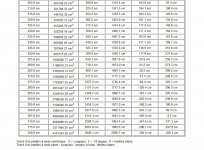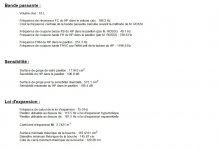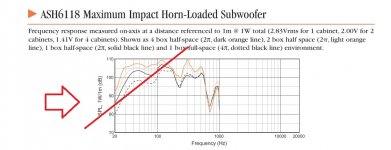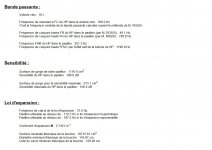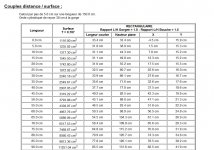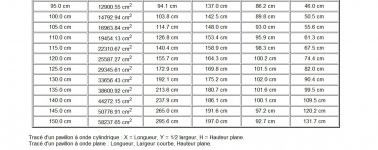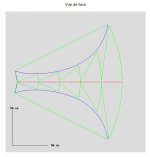I am asking for help simulating this bass bin as I am running on Mac and could never find any simulation software. Basically I have redesigned a sub, based on work done by Electro Voice (TL4050 using 15" woofer) and EAW (BH882 using 18" woofer), and were later modified by Richard Long as the famous Bertha. The Bertha had a 7.5 foot horn path, plus 3 foot Levan extension. I redesigned it with 10.5ft internal path, and the optional 3 feet deep extension. I intend to use JBL's 2242. What can be altered for best result is the throat area and back chamber volume. Current throat works on a 2:1 compression ratio with that 18" driver. Can anyone sim this bin and tell me how rear chamber volume and throat area can be improved?
TIA
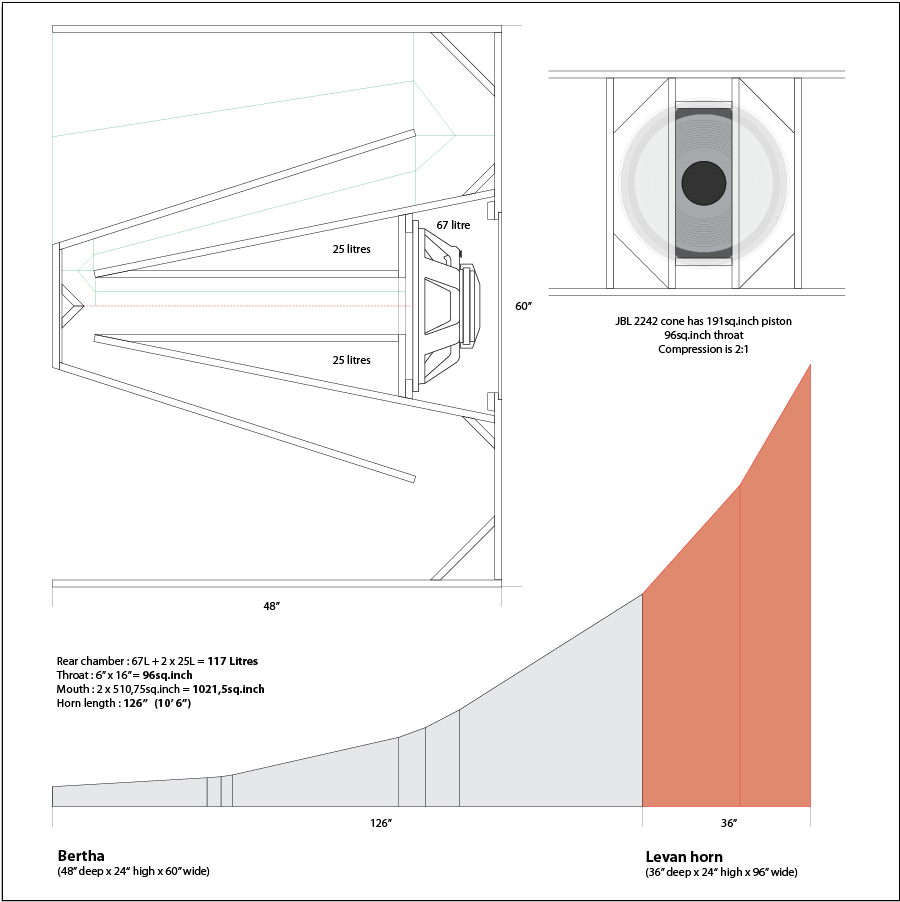
TIA

Montreal? Stereo in Montreal has some "Berthas". 4 or 5 I believe! Sound is pretty darn good there. Why not just go with the original design? Either way the sub you proposed or the Bertha are both very very large and most likely not easily transported....
Party subs. I am actually doing Half Berthas with a single woofer. Being 24" high instead of 46" high, they will be easier to move through doors ;-) And yes. Stereo has 3 Berthas (used to have 6).
In regard of your question about why changing the Berthas. The answer is simple. The Bertha is itself an improved version of the EAW, which is an improved version of the Electo-Voice. Last improvement on the Bertha was done 30 years ago. Perhaps it's time to do something. Anyway, my request is to have help simulating this horn. Hornresp is PC-only as well as most simulation softwares. And I will not buy a PC or have Windows on my Mac ;-) I even searched for Excel spreadsheets and found none.
In regard of your question about why changing the Berthas. The answer is simple. The Bertha is itself an improved version of the EAW, which is an improved version of the Electo-Voice. Last improvement on the Bertha was done 30 years ago. Perhaps it's time to do something. Anyway, my request is to have help simulating this horn. Hornresp is PC-only as well as most simulation softwares. And I will not buy a PC or have Windows on my Mac ;-) I even searched for Excel spreadsheets and found none.
Apache OpenOffice for Mac...And I will not buy a PC or have Windows on my Mac ;-) I even searched for Excel spreadsheets and found none.
Strange, how do you know this woofer is good for your application?!I intend to use JBL's 2242
Last edited:
I don't understand how it is related to my request.Apache OpenOffice for Mac
Why do you think it is not suitable? I'd be interested to hear it as so far, it is what is inside most Berthas being used in clubs. You should check the T/S parameters. They are quite good for a horn loaded cabinet.Strange, how do you know this woofer is good for your application?!
1. You said you want to use your Mac to run Excel spreadsheets or I'm wrong.I don't understand how it is related to my request.
Why do you think it is not suitable? I'd be interested to hear it as so far, it is what is inside most Berthas being used in clubs. You should check the T/S parameters. They are quite good for a horn loaded cabinet.
I am running on Mac
I will not buy a PC or have Windows on my Mac
2. It just shows in my sim an orange tag for this driver (not the best).I even searched for Excel spreadsheets and found none.
BTW When you mention that the 2242 is "not the best", are you refering as "not he best for home duty" or "not the best for PA". Those would be two very different requirements. The 2242 has a relatively low Qts (0.28) and a strong motor. The venting allows for great cooling. This is perhaps the best sound reinforcement woofer JBL has made in decades. And that's why it is widely used on dance floors. Both on bass reflex cabinets and horn loaded ones.
Other than the introduction of tapped horns, which can go much lower than a FLH for a given size, not much has changed in horn design in the last 30 years.In regard of your question about why changing the Berthas. The answer is simple. The Bertha is itself an improved version of the EAW, which is an improved version of the Electo-Voice. Last improvement on the Bertha was done 30 years ago. Perhaps it's time to do something. Anyway, my request is to have help simulating this horn. Hornresp is PC-only as well as most simulation softwares. And I will not buy a PC or have Windows on my Mac ;-) I even searched for Excel spreadsheets and found none.
Driver design has changed, drivers with more than double the Xmax of the JBL 2242 (only 7.87mm) are available now.
Due to much greater Xmax, power handling, and BL, the B&C18TBW100 would have almost 6 dB more output than the 2242 in the Berthoid, and at $349 (in the USA) probably cheaper too.
I dislike PC computers, been on Mac since the mid 80's, but run Hornresp on an old Dell PC .
You can get an old used PCs for next to nothing, cheaper than a windoze emulater.
And no, I won't be doing your design work for you for free, but I will tell you that I have not found Hornresp to be super accurate in regards to chamber size.
If you are sold on FLH, go ahead and build, then just experiment with the chamber size on the prototype. Easily done with sand bags or foam blocks, small differences in chamber volume can make some rather large differences in smoothness and output.
Art
Last edited:
I checked the T/S specs on the BC woofer and not much is available. All sites that sell it have the same minimal info. 96db efficiency compared to the JBL's 2242 of 99db. BC claims 35 to 1000Hz response, but doesn't say within how many db and no T/S available. JBL's claim is 25 to 1,6Khz response. I don't mean the BC is a bad driver, but I can't read any info on it. While the JBL 2242, as used in the ASH-6118WH horn loaded sub is flat to 30Hz with high efficiency.
JBL ASH-6118WH Specifications:
Frequency Range (-10 dB): 1 cabinet: 25 Hz – 250 Hz,
2 cabinets: 24 Hz – 250 Hz,
4 cabinets: 22 Hz – 250 Hz
Frequency Response (±3 dB):1cabinet: 30 Hz – 200 Hz,
2 cabinets: 28 Hz – 200 Hz,
4 cabinets: 26 Hz – 200 Hz
Transducer PowerRating (AES):1 cabinet:1200 W (4800 W peak), 2 hrs,800 W (3200 W peak), 100 hrs
2 cabinets:2400 W (9600 W peak), 2 hrs 1600 W (6400 W peak), 100 hrs
4 cabinets: 4800 W (19200 W peak), 2 hrs 3200 W (12800 W peak), 100 hrs
Long-Term System Power Rating (IEC):1 cabinet: 800 W (3200 W peak), 100 hrs
2 cabinets: 1600 W (6400 W, peak), 100 hrs
4 cabinets: 3200 W (12800 W peak), 100 hrs
Maximum SPL: 30 Hz – 140 Hz:
1 cabinet: 133 dB-SPL, cont avg(139 dB peak)
2 cabinets: 138 dB-SPL cont avg(144 dB peak)
4 cabinets: 144 dB-SPL cont avg(150 dB peak)
System Sensitivity (dB-SPL, 1W @ 1m):30 Hz – 150 Hz:
1 cabinet: 102 dB
2 cabinets: 104 dB
4 cabinets: 107 dB|
Nominal Impedance:8 ohms per cabinet.
JBL ASH-6118WH Specifications:
Frequency Range (-10 dB): 1 cabinet: 25 Hz – 250 Hz,
2 cabinets: 24 Hz – 250 Hz,
4 cabinets: 22 Hz – 250 Hz
Frequency Response (±3 dB):1cabinet: 30 Hz – 200 Hz,
2 cabinets: 28 Hz – 200 Hz,
4 cabinets: 26 Hz – 200 Hz
Transducer PowerRating (AES):1 cabinet:1200 W (4800 W peak), 2 hrs,800 W (3200 W peak), 100 hrs
2 cabinets:2400 W (9600 W peak), 2 hrs 1600 W (6400 W peak), 100 hrs
4 cabinets: 4800 W (19200 W peak), 2 hrs 3200 W (12800 W peak), 100 hrs
Long-Term System Power Rating (IEC):1 cabinet: 800 W (3200 W peak), 100 hrs
2 cabinets: 1600 W (6400 W, peak), 100 hrs
4 cabinets: 3200 W (12800 W peak), 100 hrs
Maximum SPL: 30 Hz – 140 Hz:
1 cabinet: 133 dB-SPL, cont avg(139 dB peak)
2 cabinets: 138 dB-SPL cont avg(144 dB peak)
4 cabinets: 144 dB-SPL cont avg(150 dB peak)
System Sensitivity (dB-SPL, 1W @ 1m):30 Hz – 150 Hz:
1 cabinet: 102 dB
2 cabinets: 104 dB
4 cabinets: 107 dB|
Nominal Impedance:8 ohms per cabinet.
Hi Lee
You can run Hornresp in Wine if you have an Intel Mac. http://www.diyaudio.com/forums/subwoofers/119854-hornresp-309.html
You can also run akabak in wine.
Start with Hornresp and export to akabak where you can add more horn segments, hornresp is limited to 4 segments. It will not do much diffence though, 4 segments will give you a very good simulation.
You can run Hornresp in Wine if you have an Intel Mac. http://www.diyaudio.com/forums/subwoofers/119854-hornresp-309.html
You can also run akabak in wine.
Start with Hornresp and export to akabak where you can add more horn segments, hornresp is limited to 4 segments. It will not do much diffence though, 4 segments will give you a very good simulation.
BTW When you mention that the 2242 is "not the best", are you refering as "not he best for home duty" or "not the best for PA". Those would be two very different requirements. The 2242 has a relatively low Qts (0.28) and a strong motor. The venting allows for great cooling. This is perhaps the best sound reinforcement woofer JBL has made in decades. And that's why it is widely used on dance floors. Both on bass reflex cabinets and horn loaded ones.
I only meant the JBL 2242H not good for horns. Take it at face value (simulation program, not my experience). I only see it being used as (front) bass reflex enclosures.
Attachments
Last edited:
Lee
Can you give the cross section areas and lengths in centimeters? Ill do the simulation for you
Can you give the cross section areas and lengths in centimeters? Ill do the simulation for you
You can download spec sheets with full TS parameters for all B&C drivers here:I checked the T/S specs on the BC woofer and not much is available. All sites that sell it have the same minimal info. 96db efficiency compared to the JBL's 2242 of 99db.
B&C SPEAKERS
Sensitivity specifications are pretty useless for comparing bass drivers, for instance a Lab 12 is only rated at 89.2 one watt one meter, but a pair are over 100 dB in the LabSub horn design.
And sensitivity does not say what will happen at high power- a pair of Lab 12s are more sensitive in my Keystone sub design than the B&C18SW115, but the B&C can go quite a bit louder because it has hardly any thermal compression at double the power the Labs can take.
I'm not sure if this is of any help (in metric/cm), 10.5 ft horn simulation for JBL 2242H.
Attachments
So, according to the sim, is the F3/Fb of that monster only 49 Hz?I'm not sure if this is of any help (in metric/cm), 10.5 ft horn simulation for JBL 2242H.
Last edited:
Thanks for posting the reference JBL ASH6118 Horn-Loaded Subwoofer for the JBL 2242H.
JBL :: Product
http://www.jblpro.com/BackOffice/ProductAttachments/ASH6118.pdf
JBL :: Product
http://www.jblpro.com/BackOffice/ProductAttachments/ASH6118.pdf
Do you see that expressed in the graphics pic of the pdf (or is it me??).JBL 2242, as used in the ASH-6118WH horn loaded sub is flat to 30Hz with high efficiency.
JBL ASH-6118WH Specifications:
Frequency Response (±3 dB):1cabinet: 30 Hz – 200 Hz,
Attachments
JBL written "Specifications" seldom seem to match the graphs.Thanks for posting the reference JBL ASH6118 Horn-Loaded Subwoofer for the JBL 2242H.
Do you see that expressed in the graphics pic of the pdf (or is it me??).
Looks like 4 of ASH6118 do a good job getting to 30 Hz, but a single rolls off below 40 Hz.
It's not very "flat" whatever that means 😀 😀, it's only half-infrasound to shake half of the crowd (make it double 2x20Hz=40Hz an octave above).So, according to the sim, is the F3/Fb of that monster only 49 Hz?
- Home
- Loudspeakers
- Subwoofers
- Sub project for PA - Help needed


